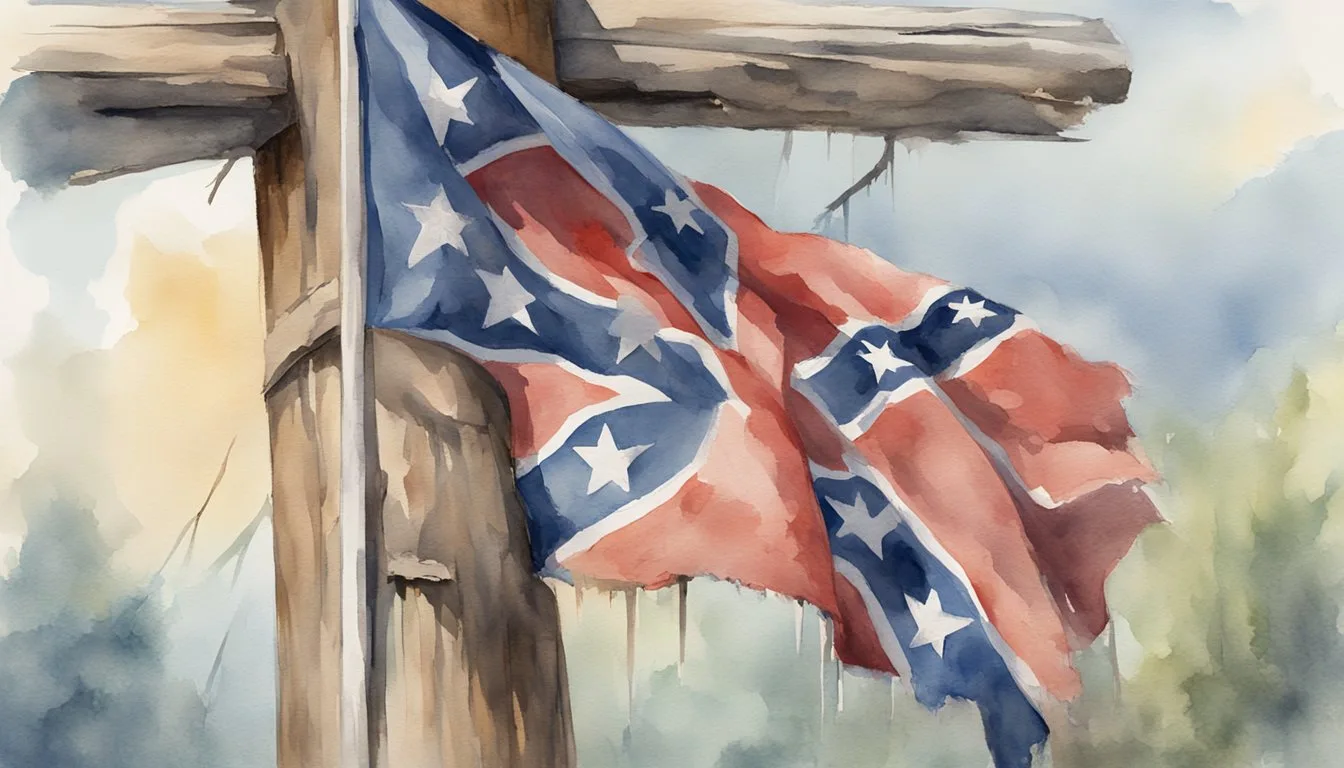Historical Context and Origin
The Confederate flag holds significant historical value, tracing back to the Civil War period, each element mirroring the tumultuous times and ideological beliefs of the southern states.
Confederate States of America Formation
The Confederate States of America was established in 1861 when seven southern slave states declared their secession from the United States. The formation was spearheaded by Jefferson Davis, who became the Confederacy’s President. This act was a direct response to the growing anti-slavery sentiment in the northern states and the election of Abraham Lincoln.
Adoption and Design of the Confederate Flags
Various flags flew over the Confederacy during its existence, with the first being the “Stars and Bars”. This national flag featured three horizontal stripes in red and white, with a blue canton containing white stars representing the seceded states. The Confederate Congress adopted it in March 1861. However, due to its resemblance to the Union’s Stars and Stripes, it caused confusion on the battlefield, leading to the design and adoption of the more recognizable battle flag.
Use During the American Civil War
Commonly referred to as the “Southern Cross” or the “Confederate battle flag,” this iconic banner was a square design with a red field crossed by dark blue saltires edged with white and bore thirteen stars. It gained prominence during the American Civil War as it was carried into battle by Confederate soldiers. While never officially adopted by the Confederate government as a national flag, its design was incorporated into later national flags. The battle flag came to symbolize Southern heritage and military valor but also became a contentious icon of the Confederacy’s defense of slavery.
Symbolism and Interpretations

The Confederate flag carries deeply imbued meanings that often ignite fervent debates. These vary from a symbol of Southern pride to an emblem of racism and hate, each interpretation steeped in America’s historical fabric.
Confederate Flag as Heritage
Many individuals see the Confederate flag as a representation of Southern heritage and a testimony to the history of the states that once formed the Confederacy. It can symbolize ancestors’ valor and the struggles faced during the Civil War. Discussions around the flag often point to its historical context, not as an endorsement of slavery, but rather as an essential component to understanding Southern identity.
Symbols of Opposition and Racism
Conversely, the visual presence of the Confederate flag can also signify white supremacy and be seen as an icon of oppression and hate. Its adoption by groups such as the Ku Klux Klan and neo-Nazi factions has tainted the flag for many, branding it as a beacon for racism. Often, when the Confederate flag is publicly displayed, it sparks controversies and serves as a stark reminder of the United States’ legacy of slavery and the ongoing struggles against racial discrimination.
Contemporary Significance and Debates

The Confederate flag has evolved from its Civil War origins to become a symbol mired in modern-day controversy. Today, it invokes intense debates over its representation, fraught with conflicting meanings of heritage and racism.
Modern Display and Controversies
In recent times, the Confederate flag, often referred to as the Southern Cross or saltire, continues to appear across various facets of culture, particularly in southern states. The display of this emblem in both public and private contexts frequently stirs debate over its interpretation. Some defend its use as a tribute to southern heritage, while others denounce it as a manifestation of racist ideologies. These disputes have often centered on symbols embedded within state flags, as seen in the contentious history of the flag of Georgia, and have led to clashes in rural communities and among non-college-educated white Americans.
Official Use and Removal from Institutions
Institutional endorsement of Confederate symbols has faced increasing scrutiny. Initiatives spearheaded by figures like former South Carolina Governor Nikki Haley have resulted in the removal of the flag from government buildings. Similarly, institutions like museums and the Democratic Party, historically associated with the Dixiecrat ideology, have reevaluated their relationship with such symbols, often leading to their removal or the recontextualization within displays that address their role in perpetuating the Lost Cause narrative.
Civil Rights and Public Opinion
Civil rights movements have significantly influenced the conversations surrounding the Confederate flag. With a substantial African American population pressing for change, the flag’s presence has been challenged due to its ties to past and ongoing racial tensions. Opinion surveys, including those conducted by YouGov, have highlighted a sharp divide in public perception, with a marked contrast in opinions between Black Americans and other groups. While some rural and largely conservative circles may claim the flag as part of their heritage, the United Daughters of the Confederacy and similar organizations have faced mounting opposition to their commemorative practices.

